#Spanish Basque composer
Explore tagged Tumblr posts
Text
youtube
José María Usandizaga (1887-1915) - Fantasia para Violoncello y Orquesta ·
Gabriel Chmura, cello
Euskadiko Orkestra Sinfonikoa · Asier Polo · ·
6 notes
·
View notes
Text
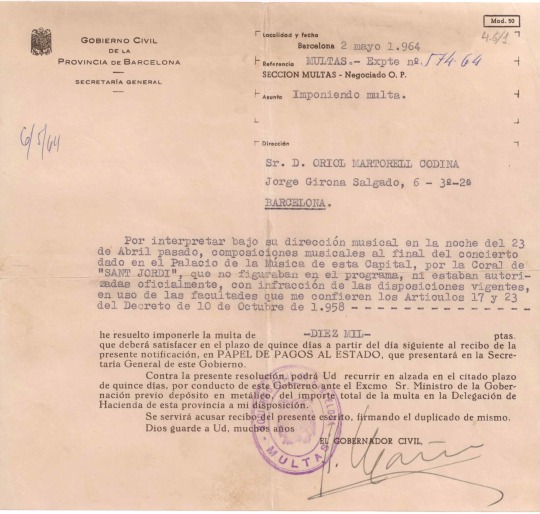
Fine that the Francoist dictatorship authorities made the director of Sant Jordi choir pay for having sung an unauthorized Catalan song on April 23rd 1964. This fine is kept as a historical document in the archive of the University of Barcelona.
General Francisco Franco's fascist dictatorship of Spain (1939-1975) banned and persecuted the use of the Catalan language for many years, allowing it towards the end of the dictatorship only in certain settings and under strict supervision of the police and censorship authorities. The dictatorship had the objective of eliminating the Catalan language, culture, and identity, and making all Catalan people become Spanish people. Cultural elements of Catalan culture were forbidden, such as certain songs, dances, and celebrations of traditional holidays, and people were imprisoned, tortured, and even sentenced to death for defending the right to exist of the Catalan people. The same persecution was suffered by the other nationalities under Spanish rule (mostly Basques and Galicians).
The choir Coral Sant Jordi, named after Catalonia's patron saint (Saint George), was founded in 1947 by Oriol Martorell. Its objective was to sing choir music with a focus on traditional Catalan music. The choir toured around Catalonia singing these songs with a great vocal quality, and became a symbol of cultural resistance against the dictatorship's attempt of ethnocide.
In the 1960s, the dictatorship wanted to become a normalized part of Europe and the international community. The regime opened Spain's borders to survive as a fascist stronghold, and thanks to the help from the USA (who was promoting fascist governments around the world), fascist Spain was accepted in the UN, normalized its relations with many countries, and opened its borders to tourism. To look more acceptable, it did some reforms among which they allowed speaking the local languages (Catalan, Aranese Occitan, Basque, Galician, etc) in public in some acts, as long as the person who was going to do it applied for official permission and turned in everything they were going to say or, in the case of a concert, the track list of all the songs that they were going to sing and all their lyrics as well as if they were going to speak between songs. The censorship authorities could accept or deny this application, and very often they censored parts of what was going to be said or sung, or whole songs.
On April 23rd 1964, the choir Sant Jordi sang in a fundraising event to raise money for a church. Like all Catholic churches, this church is under the title of a saint, virgin, or similar. In this case, the church is dedicated to Saint George, who their choir is also named after. In the concert, the choir sang an extra song that wasn't on the tracklist that they had submitted to be approved by the censorship authorities. This extra song was the "Goigs de Sant Jordi" (goigs are a traditional Catalan music genre of songs dedicated to exalting a particular saint or Virgin). This is a goigs song composed in the year 1885 in the Catalan language, which explains the saint's story and asks: "patron of knighthood, watch over my homeland and for its rebirth".
For having sung this, the Spanish government made Oriol Martorell (conductor of the choir) pay a fine of 10,000 pesetas, a huge amount at the time. Oriol appealed the resolution many times, even reaching the Supreme Court, but as was expected they did not repeal it, and he (with support from the rest of the choir) had to pay the fine.
Under the cut I've included the whole lyrics of the unauthorized song translated to English.
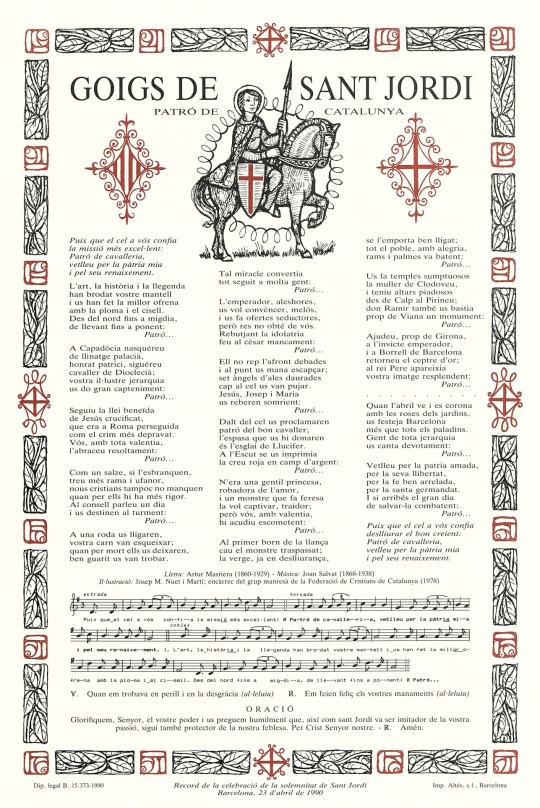
This is a print of goigs song they sang. This one is from an act in 1990, kept in the archive of Jaume I University. These are the translated lyrics:
GOIGS OF SAINT GEORGE. Patron saint of Catalonia.
Since the heaven entrusted you the most excellent mission: Patron of knighthood, watch over my homeland and for its rebirth.
Art, history, and legend have embroidered your mantle and have given you the best offering with the quill and the chisel. From the north to the south, from the east to the west: Patron...
You were born in Cappadocia of a palatial lineage, honoured patrician, you were Diocletian’s knight; your illustrious hierarchy gave you great demeanour: Patron...
You follow the blessed law of crucified Jesus, which was persecuted in Rome as the most depraved crime. You, with all the courage, resolutely embrace it: Patron...
Like a willow, if it’s stripped off its branches, it grows more branches and lushness, new Christians aren’t missing either when there’s more rigour for them. One day you spoke in the council and they destined you to torment: Patron…
You were tied to a wheel, your flesh teared out; when they left you for dead, they found you well healed. Such a miracle soon converted many people: Patron…
The emperor, then, wants to convince you, sweetly, and gives you seductive offers, but he doesn’t get anything from you. Refusing idolatry you defect the Caesar: Patron…
He doesn’t receive the affront freely and immediately orders you be beheaded; seven gold-winged angels take you up to heaven. Jesus, Joseph, and Mary welcome you smiling: Patron…
Up in heaven they proclaim you patron of the good knights; the sword they gave you there is Lucifer’s fright. On your Shield was printed the red cross on a silver field: Patron…
There was a gentle princess, stealer of love, and a ferocious monster wants to capture her, traitor; but you, with bravery, turn up to attack: Patron…
On the first lance stroke the monster falls down pierced; the virgin, already released, takes him away well tied up; all the town, with happiness, branches and palms beat: Patron…
Clovis’s wife builds sumptuous temples for you, and you have pious altars from Calp to the Pyrenees; Sir Ramir also erected for you a monument near Viana: Patron…
You help, near Girona, the undefeated emperor, and you give back the golden sceptre to Borrell of Barcelona; your shining image used to appear to king Peter: Patron…
When April comes and is crowned with the roses from the gardens, Barcelona celebrates you more than all the paladins. People of all hierarchies sings to you devoutly: Patron…
Look over the loved homeland, for its freedom, for the well-rooted faith, for the holy brotherhood. And if the great day came to save it in combat: Patron of knighthood, watch over my homeland and for its rebirth.
Since the heaven entrusted you to free the good believer: Patron of knighthood, watch over my homeland and for its rebirth.
#història#arts#música#goigs#history#modern history#1960s#catalunya#catalonia#coses de la terra#francoism#music#choir#antifascism#singing#saint george#sant jordi#cultures#resistance#franquisme
80 notes
·
View notes
Text
behind the name dash game
Edward
Gender: Masculine
Usage: English, Polish
Meaning: Means "rich guard", derived from the Old English elements ead "wealth, fortune" and weard "guard". This was the name of several Anglo-Saxon kings, the last being Saint Edward the Confessor shortly before the Norman Conquest in the 11th century. He was known as a just ruler, and because of his popularity his name remained in use after the conquest when most other Old English names were replaced by Norman ones. The 13th-century Plantagenet king Henry III named his son and successor after the saint, and seven subsequent kings of England were also named Edward.
This is one of the few Old English names to be used throughout Europe (in various spellings). A famous bearer was the British composer Edward Elgar (1857-1934). It was also used by author Charlotte Brontë for the character Edward Rochester, the main love interest of the title character in her novel Jane Eyre (1847).
Diminutives: Ed, Eddie, Eddy, Ned, Ted, Teddie, Teddy (English)
Other Languages & Cultures: Eduart(Albanian); Eadweard(Anglo-Saxon); Eduard, Edvard(Armenian) Edorta(Basque) Eduard(Belarusian); Eduard(Catalan); Eduard, Edi(Croatian); Eduard, Edvard(Czech); Edvard(Danish); Eduard, Ed, Eddy, Ward(Dutch); Eduard(Estonian); Edvard, Eetu(Finnish); Édouard, Eddy(French) Eduard(Georgian); Eduard, Edi(German); Ekewaka(Hawaiian); Eduárd, Edvárd, Ede(Hungarian); Eadbhárd(Irish); Edoardo (Italian); Eduards, Edijs, Edvards(Latvian); Eduardas, Edvardas(Lithuanian); Edvard(Norwegian); Duarte, Eduardo, Dado, Du, Duda, Dudu, Edu(Portuguese); Eduard(Romanian); Eduard(Russian) Eideard(Scottish Gaelic); Eduard(Slovak); Edvard, Edi(Slovene) Eduardo, Edu, Lalo(Spanish); Edvard(Swedish); Eduard(Ukrainian)


Instructions: go to behindthename.com find your muses's name (feel free to include aliases and last names) go to ratings take a screenshot of the results + plus other info about the name
tagged by @sanguine-salvation (thanks for tagging me!)
tagging anyone who wants to do this, do this and say that I tagged you
#?|dash games|#this was great#because i use this site very often#i bolded edoardo because he uses the italian version of his name as an alias sometimes
2 notes
·
View notes
Text
Granite Hills Bios: Angel Vega (1980)
Architecture, Criminology, Music Technology & Theatrical Studies Student A. R. Vega.

Student & Member of several groups Angel Ramon Vega.
"The University, incredible, the town, ehh, not so much."
Name
Full Legal Name: Angel Ramon Vega
First Name: Angel
Meaning: From the medieval Latin masculine name 'Angelus', which was derived from the name of the heavenly creature.
Pronunciation: AYN-jel. ANG-khel
Origin: English, Bulgarian, Macedonian
Middle Name: Ramon
Meaning: Catalan form of 'Raymond', from the Germanic name 'Raginmund', composed of the elements 'Regin' 'Advice, Counsel, Decision' and 'Munt' 'Protection'.
Pronunciation: ra-MON
Origin: Catalan
Surname: Vega
Meaning: From Spanish 'Vega' meaning 'Meadow, Plain', of Basque origin.
Pronunciation: BEH-gha
Origin: Spanish
Titles: Mr, Señor
Nicknames: N/A
Goes By: Angel (Pronounced: ANG-khel)

Characteristics
Age: 24
Gender: Male. He/Him Pronouns
Nationality: American Citizen. Born in Puerto Rico
Ethnicity: Latino. Puerto Rican
Birth Date: 26th January 1956
Sexuality: Straight
Religion: Catholic
Native Language: Spanish
Known Languages: Spanish, English
Relationship Status: Single
Astrological Sign: Aquarius
Played By: Alfred Molina

Appearance
Height: 6'3" / 190 cm
Eye Colour: Brown
Hair Colour: Black
Hair Dye: None
Body Hair: Hairy
Facial Hair: Varies
Tattoos: None
Piercings: None
Scars: None

Health and Fitness
Allergies: None
Alcoholic, Smoker, Drug User: Social Drinker, Occasional Smoker
Illnesses/Disorders: None Diagnosed
Medications: None
Any Specific Diet: None

Relationships
Affiliated Groups: Alien Seekers, Granite Hills Crime-Stoppers, Historical Re-Enactment Society, Music Appreciation Society
Friends: Easton White, Douglass Bernard, Chuck Sheppard, Quentin Hollister, Holden Lynn
Shares A Dorm With: Cesar Leon, Terry Jepson
Significant Other: None
Parents: Oriol Vega (48, Father), Queralt Vega (50, Mother, Née Borja)
Siblings: None

Extras
Classes: Architecture, Criminology, Music Technology, Theatrical Studies
Occupation: Student
Employer: None
Hobbies/Interests: swimming, ice skating, rugby, dancing, calligraphy, star gazing, magic, acting, note taking & researching, music (both creating & listening to), cooking, card games
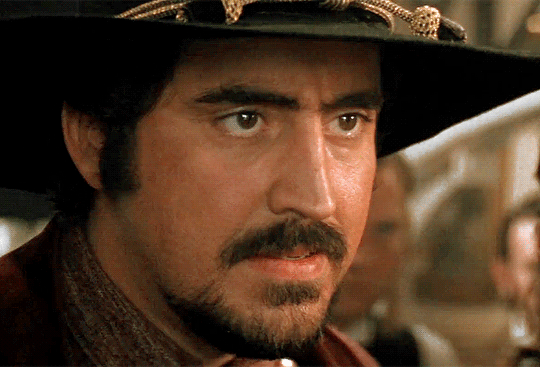
8 notes
·
View notes
Text
Introductions/First artworks
1. Hello, my name is Vivyan. One little-known fact about me is that I am the youngest person in my family to graduate from high school and attend college.
2. The artwork I was assigned is #11, which is Pablo Picasso's 1937 painting named "Guernica."
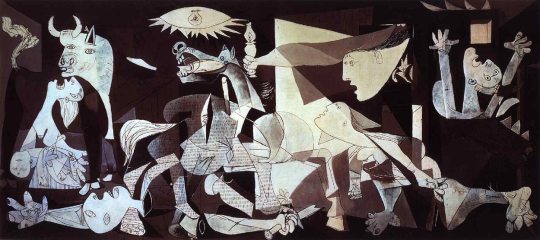
Guernica was created on April 26, 1937–June 1937
Guernica is a large 1937 oil painting by Spanish artist Pablo Picasso.
Many art critics consider it the most powerful anti-war painting ever made, and it is one of the artist's best-known works.
The artwork is displayed at the Museo Reina Sofía in Madrid.
Picasso painted Guernica in response to the 1937 bombing of Basque Country by the fascist Spanish army and its allies, a rare political statement in his art.
3. When I first took a closer look at this artwork created by Picasso, I was struck by the detailed and intricate details of the piece. The colors, shapes, and lines all seemed to be carefully composed to evoke a powerful emotional response to the viewer. While looking further into the artwork I thought the artist may have been attempting to convey the theme of suffering or hardship through this piece. After researching, my first thought remained unchanged. I can see now the artwork depicted the aftermath of a bombing, portraying the suffering and pain caused.
Date 5/8/24
1 note
·
View note
Text
youtube
"La Paloma", "The Dove" in English, is a popular Spanish song that has been produced and reinterpreted in diverse cultures, settings, arrangements, and recordings over the last 140 years. The Song Was Written By The Spanish Basque Composer Sebastián Iradier (Later Yradier) Around 1860 after a Visit to Cuba. In 1879, it was registered at the copyright office in Madrid as a "Canción Americana con acompañamiento de Piano.” Iradier Was To Die In Obscurity Within Few Years, Never To Learn How Popular His Song Would Become.
Very quickly, "La Paloma" became popular outside of Spain, particularly in Mexico, and soon spread around the world. In many places, including Afghanistan, Cuba, Colombia, Hawaii, the Philippines, Germany, Romania, Venezuela, Zanzibar, and Goa it gained the status of a quasi-folk song. Over the years, the popularity of "La Paloma" has surged and receded periodically, but never subsided. It may be considered one of the first universal popular hits and has appealed to artists of diverse musical backgrounds. There are more than one thousand versions of this song, and together with "Yesterday" by The Beatles, is one of the most-recorded songs in the history of music; it is certainly the most-recorded Spanish song.

Oh, little girl, yes
Ay, chinita, que sí
Oh, give me your love, oh
Ay, que dame tu amor, oh
Oh, come with me, little girl
Ay, que vente conmigo, chinita
Where do I live
A donde vivo yo
Oh, little girl, yes
Ay, chinita, que sí
Oh, give me your love, oh
Ay, que dame tu amor, oh
Oh, come with me, little girl
Ay, que vente conmigo, chinita
Where do I live
A donde vivo yo
Source: Musixmatch
Songwriters: Sebastian Yradier/Hardy Kingston
La Paloma lyrics © Warner Chappell Music Finland Oy, Universal Music Publishing B.v., Peer International Corporation, Hansa Musik Verlag Gmbh, Edition Intervox, Hanseatic Musikverlag Gmbh & Co Kg, Melodie Der Welt Gmbh & Co Kg, Cress Publishing Gmbh
0 notes
Text
Mocedades: Esencial 1973-1989 Remastered 2CD-New $49.99
Mocedades is a Spanish singing group from the Basque Country, who represented Spain in the Eurovision Song Contest in 1973 with the hit song “Eres tú“. Since June 2014, Mocedades has been the name of two bands: one with Izaskun Uranga as its leader and the other with Javier Garay. A third group, El Consorcio, is composed of former Mocedades members who left the group but have continued a career…

View On WordPress
0 notes
Audio
VI Piezas Sobre Cantos Populares Españoles (6 Pieces On Spanish Folk Songs) : III. Vascongada - Basque Dance
By Composer Enrique Granados
Douglas Riva, Pianist
#basque dance#spanish folk songs#enrique granados#spanish composers#late romantic period#early 20th century period#classical music#audio#audio post
82 notes
·
View notes
Text
Tongo, tongo, tongo (Or How Benidorm Fest ended being Steal Fest).
So, Spain just celebrated Benidorm Fest to chose our representative/s in Eurovision and let me tell you, half Spain is not happy at all with the results, including me.
Maybe nobody cares about this, but I have to get it out of my chest.
This year was very special for me because of a song: Terra, by the Galician trio Tanxugueiras (pronounced something like tan-shoo-GAY-rahs). It's a song that is very traditional but modern at the same time. Some people have even called Tanxugueiras "electro-meigas". Meigas is what we call witches in Galicia (for those who don't know, Galicia is that bit right above Portugal). We speak Galician and Spanish, we have Celtic roots, and often our culture is depreciated, ridiculed and ultimately, disregarded and forgotten. As you may have guessed, I am from this region of Spain, so it hits close to the heart.
Terra was one of the candidates this year, and everyone and their mother was very excited about it. There were people in other parts of Spain who didn't understand a single word of the song, saying the music spoke to them, supporting Tanxugueiras. Roughly two thirds of Spain were prepared to have them perform at Turin. Even some people outside Spain were saying things like "if you don't select them as your representation, you'll be foolish, that's the best song".
There were other songs, of course, and other people had other favorites. Eventually, it was almost a tie between them and Rigoberta Baldini's song, Ay Mamá, which was somewhat of a feminist ode to mothers. At least a tie regarding popular vote, though Tanxugueiras were a bit ahead. The jury... well, let's not speak of them or I'll start to break stuff.
Anyway, do you know who won?
None of them.
The "winner", was Chanel's generic pop song with English words and reggaeton flavor nº 364, SloMo. Which is fine to those who like that kind of music (not me), but personally I feel like it's the 10th attempt to do what Eleni Foureira did (and better done) in 2018 with Fuego.
We had an opportunity to do something different, and the jury threw it down the drain, despite what the public wanted.
Now there's people saying SloMo does not fulfill the requisites of Benidorm Fest to have the songs written in an official language (Spanish), a co-official one (Galician, Catalan, or Basque, mainly), and also don't have more than a certain percentage of the words in English. Which, give the song is written in Spanglish, I am inclined to believe it's true.
Feels like we've been robbed. Others have articulated it better than me, but basically, those of us who supported either Tanxugueiras or Rigoberta feel like the song was already chosen to begin with and the whole Benidorm Fest was nothing more than a game or a play to give us some sense of participation, like we, the public, were actually deciding for once in the last 10 years. Just theater, but nothing of substance.
I have nothing against Chanel as an artist, but it can't be a coincidence that the winner is the one with the major music label behind and with professional connections to members of the jury. Now there also have arisen some accusations of plagiarism, which is a problem legally for the writers/composers of the song, since Chanel is only the performer, but things are not looking good overall.
End rant.
In case you liked Terra and want to listen to more songs by Tanxugueiras, I'll leave you with my two favorites, Midas and Figa, but you can find their whole albums on Spotify as well, and their videoclips are worth a watch (I didn't link them to keep things neutral, but they're easy to find).
70 notes
·
View notes
Text
youtube
Juan de Anchieta (1462 – 1523) - In passione Domini
Choir: DaltroCanto
Conductor: Dario Tabbia
2 notes
·
View notes
Photo

Raimundo de Madrazo - Portrait of Eduardo Zamacois y Zabala - 1863/64
Raimundo de Madrazo y Garreta (24 July 1841 – 15 September 1920) was a Spanish painter from the Madrazo family of artists who worked in the Realistic style, although his later work shows signs of Rococo and Japanese influence. He was known primarily for his genre paintings and portraits. His grandfather was José de Madrazo, his father was the portrait painter Federico de Madrazo and his brother was Ricardo de Madrazo.
Eduardo Zamacois y Zabala (2 July 1841 in Bilbao – 12 January 1871 in Madrid) was a Spanish Academic painter who specialized in small-scale canvases. He was the father of the French writer, Miguel Zamacoïs, brother of the writer Niceto de Zamacois, the singer Elisa Zamacois and the actor Ricardo Zamacois, and also an uncle of the writer Eduardo Zamacois and the music composer Joaquín Zamacois.
Eduardo María Zamacois y Zabala was born in Bilbao, Spain; the son of Professor Miguel Antonio de Zamacois y Berreteaga (1794-1863), and his second wife, Ruperta María del Pilar de Zabala y Arauco. His father was the founder and director of the Santiago de Vizcaya School of Humanities. His relatives included numerous artists: writers, actors and musicians. Of Basque ancestry, their surname originated in Hasparren, France, where it was originally spelled "Samacoys".
He received a thorough education, which included drawing classes with a local artist named Joaquín Balaca (c.1820-?). Later, when his father's school closed, the family moved to Madrid and, in 1856, he was enrolled at the Real Academia de Bellas Artes de San Fernando, where he studied with Federico de Madrazo.
In 1860, on Madrazo's recommendation, he went to Paris and attended the classes of Charles Gleyre in preparation for applying to the Ècole des Beaux-Arts. His application there was denied, so he turned to the workshops of Ernest Meissonier, where he found a position.
A skillful business negotiator, he strove to gain access to as many European exhibitions as possible. Success came quickly. In 1861, he was commissioned to create decorative paintings in the quarters of the future king, Alfonso XII at the Palacio Real de Madrid. This work won him a grant from the Diputación Foral de Vizcaya [es], which enabled him to continue his studies. In 1862 and 1864, he was awarded medals at the National Exhibition of Fine Arts.
He was married in Paris in 1865, to Louise Marie Héloise Perrin, whom he had met at the home of his friend, Jehan Georges Vibert. They had two children: Miguel Louis Pascual, who became a well-known journalist and playwright, and a posthumous daughter, Marie Hélène, (who married the painter, Jean Alfred Marioton).
In 1866, he became good friends with the painter, Marià Fortuny, who did a portrait etching of him. During a trip to Rome, Zamacois also posed as a toreador for Fortuny's painting, The Spanish Wedding. Later, he contacted his friend, Adolphe Goupil, and put him in touch with Fortuny, which resulted in an exclusive contract with Goupil & Cie; a turning point in Fortuny's career.
In 1870, he was awarded the Gold Medal at the Salon for his painting, The Education of a Prince. After a showing in London, one of his paintings was purchased by Charles Dickens.
The Franco-Prussian War created difficulties that eventually forced him to return to Madrid. His arrival there coincided with the official coronation of King Amadeus I, and he attended the ceremonies. It was an unusually cold winter and he became ill the following day. He died there suddenly, aged 29, of what was described as "gangrenous angina" (possibly Diphtheria).
In 1878, he was awarded a posthumous diploma by the École des Beaux-Arts and a major retrospective at the Exposition Universelle. Goupil & Cie also published a large volume of photographs of his major works.
8 notes
·
View notes
Text
Olentzero
The name Olentzero appears in a number of variations: Onenzaro, Onentzaro, Olentzaro, Ononzaro, Orentzago and others. The earliest records give the name as Onentzaro and the name is most likely composed of two elements, on "good" plus a genitive plural ending and the suffix -zaro which in Basque denotes a season (compare words like haurtzaro "childhood"), so "time of the good ones" literally. This suggests a derivation similar to the Spanish nochebuena, but the origin of Onentzaro, corresponding to the old feast of the winter solstice, is older than that of Christmas.
Other theories of derivation exist but are not generally accepted: from a metathesis of Noël, theory of S. Altube from a fusion of O Nazarene from Christian liturgy, theory of J. Gorostiaga from oles-aro "alms season", a phonologically impossible derivation by Julio Caro Baroja In parts of Navarre this holiday is called xubilaro or subilaro from subil, the word for a Yule log plus the suffix -zaro. In parts of Lower Navarre the word suklaro is used, a contraction of sekularo. Sekularo has no clear etymology but is likely to be related to Latin saecularis.
There are many variations to the Olentzero traditions and stories connected to him, sometimes varying from village to village. The first written account of Olentzero is from Lope de Isasti in the 17th century: A la noche de Navidad (llamamos) onenzaro, la sazón de los buenos ("To Christmas eve (we call) onenzaro, the season of the good ones"). One common version has Olentzero being one of the jentillak, a mythological race of Basque giants living in the Pyrenees. Legend has it that they observed a glowing cloud in the sky one day. None of them could look at this bright cloud except for a very old, nearly blind man. When asked to examine it, he confirmed their fears and told them that it was a sign that Jesus would be born soon. According to some stories, the old man asked the giants to throw him off a cliff to avoid having to live through Christianisation. Having obliged him, the giants tripped on the way down and died themselves except Olentzero. Other versions have the jentillak simply leaving, with only Olentzero remaining behind to embrace Christianity.
Parts of Olentzero legend are reminiscent of a prehistoric cult rituals surrounding the winter solstice, such as the involvement of ritual "last meals" and sacrifices of rebirth. Other versions of the Olentzeroren kondaira, or "history of Olentzero", tell that as a new born he was abandoned in the woods and was found by a fairy who gave him the name Olentzero, bestowed gifts of strength and kindness on him and handed him to an older childless couple living alone in the woods. He turned into a strong man and charcoal burner who was also good with his hands, carving wooden toys that he would carry in a big charcoal bag to give to the children of the village. It is said that he died one day saving children from a burning house and that when he died, the fairy who had found him granted him eternal life to continue to bring joy to children and people.
Other variations of the legend, customs and the character include:
in Areso children would be told to come home early. An adult would then dress up as Olentzero and scare the children still out on the streets with a sickle.
in Uharte-Arakil he was traditionally suspended from a rope from a window, dressed in a straw mantle, in Lekunberri the effigy was attached to the chimney.
in Berastegi if the children did not want to go to bed, a sickle would be thrown down the chimney and the children told that Olentzero would come to cut their throats if they did not go to bed.
in Dima a straw puppet dressed as Olentzero with a sickle would be hung from the church tower after the midnight mass on Christmas Eve and if children had been behaving badly, people would say Onontzaro begi-gorri txaminira da etorri, austen baldin badegu barua, orrek lepoa kendu guri "Olentzero with the red eyes has come to the chimney, if we break the fast, he will cut our throats" - referring to the traditional fast in the week before Christmas.
in Larraun he was called Ononzaro and said to have three eyes and usually depicted as a drunkard dressed like a scarecrow. People would ask Ononzaro begi-gorri, non arrapatu duk arrai ori? (Olentzero of the red eyes, where did you catch that fish (i.e. inebriation)?) and the answer would be Bart arratseko amaiketan Zurriolako arroketan (last night at eleven in the rocks of Zurriola).
Around 1952, in Francoist Spain, a group called Irrintzi Elkartea from Zarautz began to revive the Olentzero traditions. Some of the more gruesome elements were removed to make Olentzero more suitable for young children and to remove elements which were deemed too pagan. From 1956 onwards, the revived Olentzero traditions began to spread outside those parts of Gipuzkoa where the traditions hailed from. During the 1970s he began to take on further new attributes, such as the bringer of gifts in attempts to find an alternative to the Spanish tradition of the Magi and the French Père Noël, summed up in the slogan Erregeak, españolak "the Three Wise Men are Spanish". Today Olentzero is celebrated all over the Basque Country and coexists with the Magi, Père Noël and Father Christmas, some families choosing to celebrate one or more at the same time.
In the modern version, Olentzero is depicted as a lovable character, widely attributed to being overweight, having a huge appetite and thirst. He is depicted as a Basque peasant wearing a Basque beret, a farmer's attire with traditional abarketa shoes and smoking a pipe. Whether he has a beard or not is not yet an established tradition. Sometimes his face is stained with charcoal, as a sign of his trade as a charcoal-burner. On Christmas Eve, groups of people or children carry effigies of Olentzero around on a chair through the streets, singing Olentzero carols and collecting food or sweets (not unlike the American trick or treat) and the traditions surrounding the holiday of Santa Ageda in the Basque Country where oles egitea "asking for alms" is practised. At the end, it is customary in some places to burn the Olentzero, for example in Lesaka.
Variation is still common, both regionally and culturally depending on whether the pagan or Christian aspects of Olentzaro are being emphasised. Near the sea, he is usually takes on more marine attributes, inland he remains thoroughly rural in nature.

36 notes
·
View notes
Text
Some of my muses’ name meanings
//It originally had more than this, but I’m not willing to go through all that again after Tumblr ate it the first time. So I’m only going to do 4 & may do more at a later time.

Vega Gennesis Lustirra of Lyrae
Vega - In Arabic, it can either mean "falling/swooping vulture” or “the descending/falling eagle”. A variation of this is Falling Star. In Spanish, it either mean “a large plain or valley”, typically a fertile and grassy one, or “Dweller of the meadow” or “One who lives on a plain”. There is another meaning of Pre-Roman origin that happens to be a title for Jesus’s mother, Mary, which is “Maria de la Vega”.
Gennesis - A respelling of the name Genesis. In Latin, it means “generation, creation” while it means “In the beginning” in Hebrew.
Lustirra - It’s a combination of the words “Luster” & “Terra”. But another influence of this last name creation happens to be “Tirra-lirra”, which means “an imitation of a musical sound“.
Lyrae - From the star, Alpha Lyrae.

Corvallis Eldridge Uriel Miosottis
Corvallis - It’s basically a name of a city in the state of Oregon. But from I’ve read, it means “heart of the valley“ in composed Latin.
Eldridge - In both German & English, it means “Sage ruler” or “Old or Wise ruler”.
Uriel - A name of one of the angels. It can mean “Light of God/God is my light”, “Angel of light”, or “Flame of God/God’s Flame”
Miosottis - A respelling of Myosotis, which is the genus of herbs/plants. One of these plants in that genus happens to be Forget-Me-Nots.

Altair “Kestrel” Cadogan Segoviano
Altair - Means “Eagle/Flying Eagle” or “Falcon” in Arabic while it can mean “Star” in Greek.
Cadogan - It’s of Welsh origin that means “Battle glory” or “Honor”
Segoviano - There’s a personal reason as to why this is his last name. Anyway, the last name was inspired by the city of Segovia in Castile. But the name of the city is of unknown origin. A shortened version of this name (Segovian) means sepulcher in Basque. Though, “Sego” does mean “Victory” in Celtic, while “Via” has that same meaning in Roman.
[BONUS] Kestrel - A Nickname that comes from the American Kestrel, which is the smallest falcon in North America.

Eridan “Wren” Amitornis Stigander
Eridan - From Eridanus, which is a modern constellation.
Amitornis - A respelling of Amytornis, which is the scientific name of the grasswren.
Stigander - A respelling of Stigandr. It is of Old Norse origin that means “Wanderer” or “stepping/treading one”
[BONUS] Wren - A nickname that is a reference to the first part of the grasswren’s scientific name, “Amytornis”.
#All Things Have An Origin | Muse Info/Headcanons#The Undaunting Interdimensional Goddess | Vega Lustirra#Stahllewolt Kingdom's Renowned Lieutenant General | Altair Segoviano#Kind-Hearted Abomination | Corvallis Eldridge Miosottis#The Mercenary On A Neverending Journey | Eridan `Wren` Stigander
3 notes
·
View notes
Audio
(joeyboy1970)
I named this mix the "Chill and Sizzle Mix" because after completing it, I felt oddly cool and perspiring at the same time. The music is inviting, sensuous, lyrical, predominantly from string instruments (accompanied by some voices and some woodwinds/brass here and there).
I loved creating this mix with DJ Reydan as it evoked feelings that could not stem from listening to modern music. It is a departure from the traditional sense of mixed music -- I call it blended music.
As before, we do not own the copyrights to any of the tracks. They belong to the original composers and the artists and musicians who created them and their heirs. We (Reydan and I) assert ourselves as the author of this mix.
Please let us know what you think by commenting on the mix. Share the mix by reposting it or sharing it on other social media platforms.
We hope you enjoy, listen, share and come back for more.
The Chill and Sizzle Mix Track and Artist List
1. Zeybekiko, Greek Music for guitar by Fernando Perez. Ελληνική μουσική για κιθάρα 2. Cecilio Perera plays Cielito lindo, La llorona y El son de la negra. 3. Veera Don't Leave by Andi Otto & MD Pallavi 4. Oblivion NADiA Kossinskaja by Astor Piazzolla Tango Nuevo 5. Jig and Two Reels by Stephen Wake 6. Basque Folk Music - Piztiak - Performed by Tartalo Music & Ian Fontova 7. Arabic Instrumental Belly Dance Music NIGHT AT THE CASBAH - Al Marconi 8. Return to Kintail/Calliope House by Stephen Wake 9. Verdes Anos by Duo Raposo 10. Matadorian - Al Marconi 11. Arriba Pichátaro (el ponte duro) by Grupo Tumbiecha 12. Flamenco by Pippo Noviello 13. Avocado by Mark Barnwell 14. Asturias (Isaac Albéniz) by Alexandra Whittingham 15. Suton by Tebra 16. Istok by Tebra 17. Gnossienne No.1 - Erik Satie, performed by Arash Ahmadi 18. Moraito_ Sor Bulería (taken from The Rough Guide To Flamenco Guitar) 19. Anathema by Al Marconi 20. A Don Agustín Bardi - Il Faut tango duo 21. Spanish Love Song by Dori Chitayat 22. Solamente Tú by Pablo Alboran 23. The Slide From Grace - Slip Jigs by John McSherry 24. Nada Aradhana - Vocal (Female) and Guitar Dhyanalinga 25. Festive Mexican Dance Music by Romantic Guitar Master
6 notes
·
View notes
Text

How Spanish cinema hit the big time

MADRID
With a Golden Bear for Spanish director Carla Simon and four compatriots nominated for Oscars, including superstars Javier Bardem and Penelope Cruz, Spanish cinema has now begun to captivate a global audience.

When Bardem and Cruz, who have been married for over a decade, were both tapped for Oscars, the 53-year-old actor could hardly contain his excitement.

"The fact that (Penelope's) nomination was for a role in Spanish... seems really extraordinary, even historic in terms of the Spanish brand," he said in February.

Unlike other countries with a long and distinguished history of cinema, Spain has struggled to establish itself on the international stage.
So far, Luis Bunuel has been the only Spanish director to win the coveted Palme D'Or at Cannes Film Festival for his provocative 1961 feature "Viridiana".
But all that is changing, with Spanish cinema increasingly recognized for its contribution to the silver screen, the most recent being Carla Simon's triumph at this year's Berlinale where she took the top prize for "Alcarras" (2022), a Catalan drama about peach farmers.
And according to Variety magazine, Cruz is rumored to be in the running for president of the jury at Cannes, an honor already bestowed upon the legendary Pedro Almodovar, by far Spain's best-known filmmaker.
Cruz herself is the only Spanish actress ever to win an Oscar, taking home the gong in 2009 for best supporting actress in the Woody Allen comedy "Vicky Cristina Barcelona".
And if she wins best actress at the Oscars later this month for Almodovar's "Parallel Mothers", it will be a coup for a film entirely "Made in Spain", whose soundtrack has also been nominated for best original score.
The score was written by Basque composer Alberto Iglesias, who has worked with Almodovar for two decades on 13 of his films. This is the fourth time an Iglesias soundtrack has been nominated for an Oscar.
For him, there is "strong momentum" within Spanish cinema.
"There is an energy... it has to do with the film schools that have been working for a long time to create new filmmakers," he told AFP.
"It has been really difficult for Spanish cinema to cross the threshold and get into these big international festivals," explains Pilar Martinez-Vasseur, director of the Spanish Film Festival in the French city of Nantes.
Spanish films which have received acclaim abroad are often not identified as such, she said, pointing to the 2001 psychological thriller "The Others" starring Nicole Kidman which was directed by Spain's Alejandro Amenabar.
"In Spain, we still have the idea that Spanish cinema is bad, that it's a nest of communists, that filmmakers are pampered, they do nothing and get subsidies," she said, calling for greater support from the government.
Filmmaking in Spain receives far less state aid than in France, experts say.
Spanish cinema has had to "learn how to break into a globalised ecosystem," said Beatriz Navas who heads the Institute of Cinematography and Audiovisual Arts (ICAA), which is subsidized by the culture ministry.
"This hasn't happened overnight because you need some sort of 'greenhouse' environment where filmmakers can work with freedom," she told AFP. "And the 'incubation time' needs to be sufficient for these productions to achieve the recognition and prestige they deserve."
As well as Cruz, Bardem and Iglesias, Spain also has a fourth horse in the Oscar race in the shape of Alberto Mielgo's "The Windshield Wiper" which has been nominated for best animated short film.
"This is the best moment for Spanish cinema," said Jose Luis Rebordinos, director of the prestigious San Sebastian film festival.
"We are making a lot of cinema and audiovisual productions in Spain, as well as for streaming platforms which is bringing a lot of work so Spanish film technicians are getting better and better," he said.
Spain's Western-friendly landscapes have drawn Hollywood directors since the 1960s and is becoming an increasingly popular destination for filming series -- Netflix, which set up its first European studios in Madrid in 2019, scored huge hits with "Money Heist" and "Elite".
Last year, the government said it wanted Spain to become Europe's "audiovisual hub", pledging to inject 1.6 billion euros to expand the film and TV production sector by 30 percent by 2025.
"International critics are increasingly focusing on our cinematic output thanks to figures like Almodovar, Javier Bardem and Penelope Cruz," said Rebordinos. "They are finding ways to draw more attention to Spanish cinema."
2 notes
·
View notes
Link
Just yesterday I reblogged this post by @beautiful-basque-country about when Spain banned all names in Basque, Catalan, Aranese, Galician, Asturian. Today I woke up and saw these news: a judge bans naming a girl Mel even though there are already 125 women named Mel registered in Catalonia.
Between 1938 and 1975, only Spanish names were allowed and everyone from the local cultures whose land is occupied by Spain had to translate their names by law. It was illegal to have names in local languages other than Spanish in your tomb too (and in fact we didn’t get legal permission to write epitaphs in tombs in the Catalan language until 2005).
However, after the death of fascist dictator Franco in 1975, local languages were legalised again, and people could finally change their names in legal documents from Spanish to the equivalent in their own languages.
So nowadays we supposedly have the right to name our children in our language, the problem is that a judge still has to accept each name, and sometimes they don’t.
In this case, two parents wanted to name their baby girl Mel, a femenine noun that means “honey” in Catalan. The judge denied because the only etimology of “Mel” he accepts is that “it is a male name of Hebrew origin”.
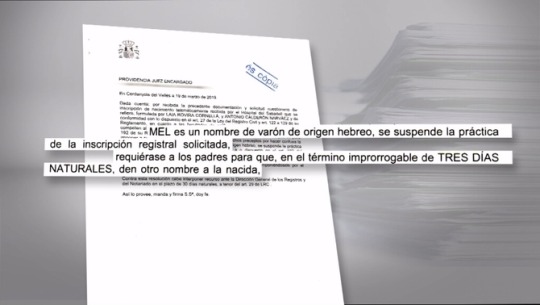
The judge gave parents 3 days to change her name, and if they didn’t do it the administration would assign her a name. The parents registered her as Adela, but are trying to get the name Mel accepted. They’ve been trying for a year and a half, and the resolution of the case could take a year and a half more.
The reason I wanted to post this is because it’s not an isolated case. Just some months ago, I heard about a girl who was forbidden from being named Pau. Here’s a newspaper article about that case (in Catalan).
Pau is a femenine word that means “peace” in Catalan. It is part of two names: Pau can be our equivalent of Paul (so a masculine name), or part of Maria de la Pau (Mary of Peace, shortened to Mari Pau or Pau). Mari Pau is a very common name in Catalan, like many other composed named of Maria + [something else]. But even if that long name is the legal name, these girls are usually called in their everyday lives by their last word. For example, women named Maria del Mar (Mary of the Sea) are usually called just Mar (Sea). Nowadays, many women are even legally just named Mar.
Denying a family the name “Pau” for a girl shows a complete ignorance of the way Catalan names work. And, by the way, even though it’s not legal to name a girl Pau (“peace” in Catalan), it is perfectly legal to name her Paz (“peace” in Spanish).
Pau’s case had a happy ending. The parents went to the radio and their case became well know. With pressure from society, in the end the judge received orders to accept the name. Let’s hope the same happens to Mel!
Tl;dr: Catalan people are legally allowed to have names in Catalan since 1975, but there are still Spanish judges that have the power to ban certain names, basing their decision on their lack of understanding of Catalan naming customs.
Though these cases are exceptions and the great majority of names are accepted, I wanted to bring attention to these two recent examples because we shouldn’t be leaving anyone behind, nor permitting officials to take the liberty of banning perfectly normal names.
I based this post on the situation of the part of Catalonia under Spanish administration, but remember there is a part of Catalonia called Northern Catalonia that is occupied by France. It is much worse there, since France doesn’t recognise any ortographic signs that aren’t part of the French alphabet. So normal Catalan and Occitan names like Martí or Víctor are banned because French doesn’t have í, or the same happens to Basque and Breton names that have ñ.
85 notes
·
View notes